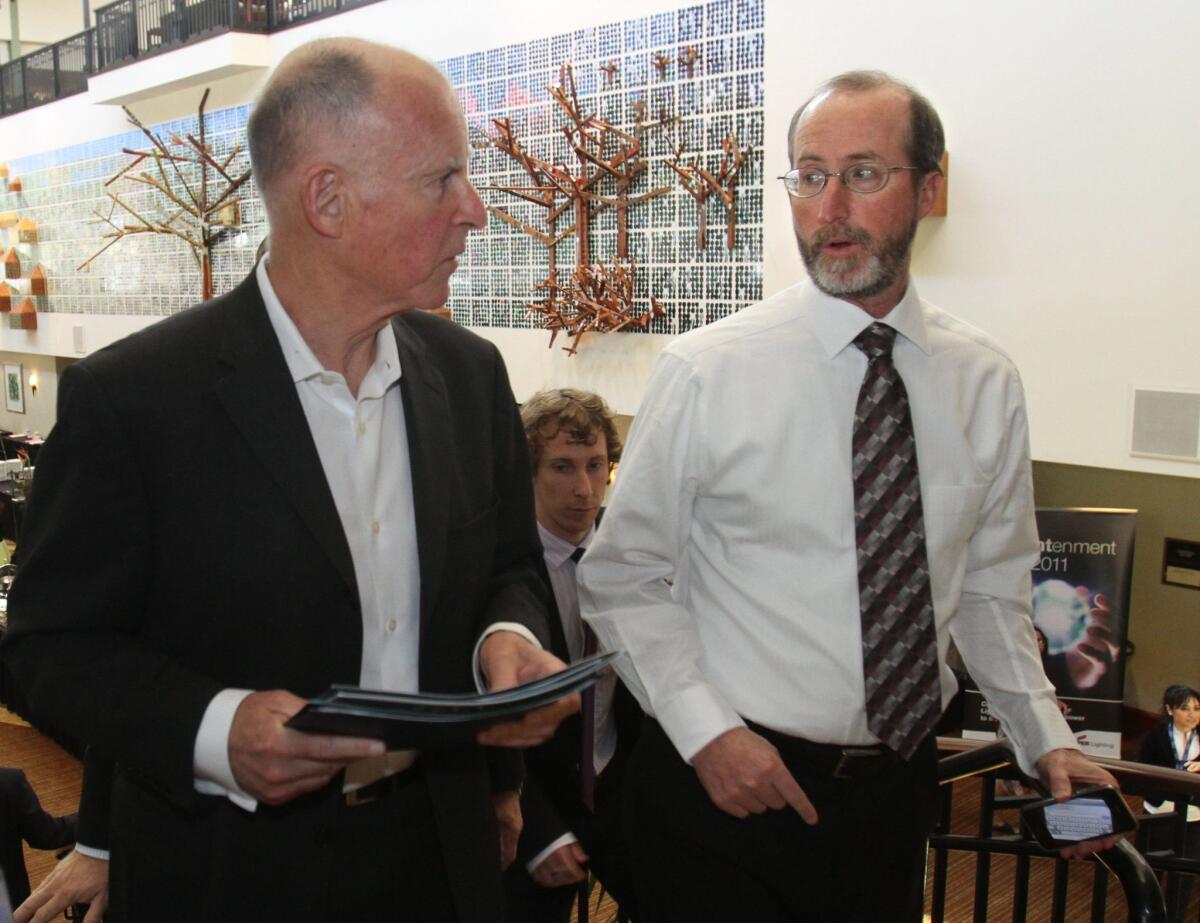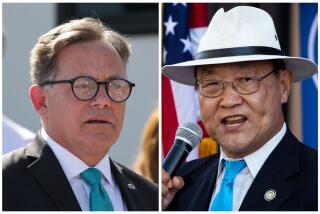Analysis: Organized labor comes up short in Democratic state Senate runoff

Orinda Mayor Steve Glazer, seen in 2011 with Gov. Jerry Brown, won a special election Tuesday to an East Bay state Senate seat.
- Share via
Finally, the barrage is over in the East Bay. Tuesday night’s special election for a state Senate seat closed a $9-million assault of mailers, television ads and radio commercials that led to the victory of a Democrat backed by Republican interests over his own party’s weightiest ally, organized labor.
The win by Steve Glazer, the Orinda mayor and veteran political strategist, over Concord assemblywoman and fellow Democrat Susan Bonilla was an embarrassment to the state’s politically powerful unions, which had spent millions to defeat Glazer only to see him win by more than 9 percentage points.
The unions will argue that it was less a defeat for them than a victory for Glazer’s deep-pocketed allies, a consortium of billionaires, millionaires and education reformers who salvaged his Senate bid with independent campaigns on his behalf. But organized labor put Glazer in their sights years ago, so his victory — a year after they helped defeat him in an Assembly race — shows the limits of their power when both sides wield all the weapons that money can buy.
Yet the mutual hatreds and odd alliances that defined Tuesday’s race also mean that it may have limited use as a template in many future contests. In the end, it may stand less as a groundbreaking political race than a noxious grudge match -- one likely to be renewed.
For the state’s unions, the battle against Glazer was born of, among other things, his support of two Democratic candidates they opposed, his objections to allowing local transit workers to strike and his desire to curb pension benefits and other protections for public employees. And it was meant to serve notice on others in the party that with union money comes the expectation of loyalty.
For Glazer’s partisans, the battle provided a chance to carve out room in the Democratic Party for more moderate views on issues dear to labor, including education measures that would lessen the sway of teachers’ unions.
Not surprisingly, Bonilla and Glazer at times seemed secondary actors in their own play, as spending by independent committees working for the candidates dwarfed the financial resources of the two running for the seat.
Just one of the myriad independent committees backing Bonilla, an effort by service employees and teachers unions dubbed Working Families, had spent more than $3.3 million before election day, according to calculations by the nonpartisan California Target Book. Other labor groups each kicked in hundreds of thousands more.
And the millionaires and billionaires who back charter schools and other changes to the state’s education policies -- including Southern California businessman Bill Bloomfield -- poured in $4 million for Glazer. An additional $1.1 million was contributed by JobsPAC, the business community behemoth.
Spending reached levels that would finance a U.S. Senate race in some states, and the results weren’t pretty. But that’s not why it will be hard to replicate elsewhere.
For one thing, this was a special election, meaning that into it flowed all the available resources. No other legislative, congressional or statewide races competed for money. And the astonishing level of spending may have reinforced the low turnout that troubles all special elections. The latest returns showed that about 110,000 ballots had been counted -- with more outstanding -- out of nearly 490,000 registered voters.
“I think people were just turned off,” said local Democratic political strategist Lisa Tucker. “There’s only so many pieces of mail you can get saying the same thing. The vitriol was out there and people were turned off.”
Races in most districts are not terribly competitive, and elections that aren’t theoretically winnable don’t draw attention and money. Steve Maviglio, a spokesman for the anti-Glazer labor operation, argued that the race was “such a perfect storm of odd events” that it was unlikely to be repeated.
“Either side that wants to walk away and say this was a watershed election is wrong,” he said.
The intriguing asterisk, though, is whether the Glazer race provides a specific road map under the state’s relatively new electoral rules that thrust the top two primary finishers, regardless of party, into a runoff.
Had Glazer been playing under the old rules -- in which each party selects its nominee for the general election -- he wouldn’t have been in the runoff at all. His victory relied on the absence of a strong Republican candidate, which made the top-two runoff a wholly Democratic fight.
Under that construction, Bonilla was the Democratic establishment favorite. Glazer -- ironically, considering his 40-year record in liberal Democratic politics in the state -- was the insurgent who coalesced independents, Republicans and a minority of the Democratic vote to forge a victory.
Since the Senate district mirrors the state in voter registration, it’s not hard to see the allure of his path for someone like Steve Westly, the former state controller and unsuccessful 2006 gubernatorial candidate who has been looking at a 2018 run for governor.
If Republicans forward a smattering of weak candidates for the governor’s race, as they have for the 2016 U.S. Senate race, that increases the odds that the finalists will be two Democrats. And it increases the odds that someone like the wealthy Westly could elbow his way into a second slot behind the Democratic establishment favorite -- at this point, Lt. Gov. Gavin Newsom -- with the same groups of voters that put Glazer over the top. (Westly, notably, endorsed Glazer.)
Whatever the machinations of that race, both sides in the Senate District 7 contest were girding Wednesday for what may be a renewed battle in 2016. Labor will have other targets next year and it may seem difficult to imagine so much money focused on one seat. But long-held grudges die slowly.
“He ran an anti-union campaign; this wasn’t about not agreeing on a few issues,” Maviglio said in an interview before the depth of Glazer’s victory was apparent. “The bulk of his money came from Republican interests and Republican donors. This is not a battle for the heart and soul of the Democratic Party.”
In a statement released later, he issued a warning of sorts, noting that Glazer received a minority of the Democratic vote, “which will not be sustainable in future elections.”
Glazer, for his part, was seeking conciliation at the end of the angry campaign.
“One new state senator can’t change California government on his own, but I hope to work with my colleagues to restore confidence in public policymaking and advance progressive ideals in ways that are financially responsible,” he said in a statement late Tuesday.
But he added a subtle jab of his own: “Today we saw that people are more important -- and more powerful -- than special interests, and that’s a great message for our state to hear.”
For political news and analysis, follow me on Twitter: @cathleendecker. For more on California politics, go to latimes.com/decker.
More to Read
Sign up for Essential California
The most important California stories and recommendations in your inbox every morning.
You may occasionally receive promotional content from the Los Angeles Times.














